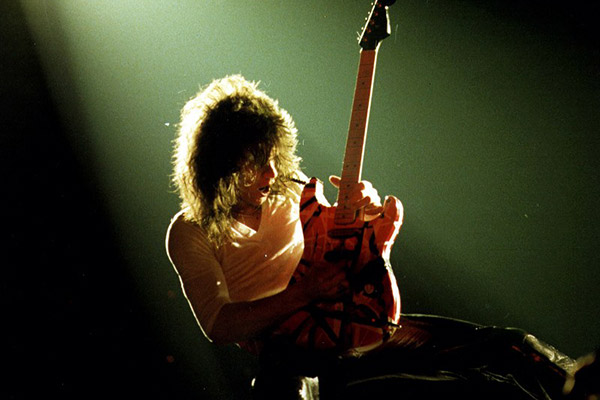Eddie Van Halen wasn’t just a rock and roll icon, but a tasteful composer and musician
Alexander Carpenter - 20 October 2020

Eddie Van Halen offered “best of both worlds”: a virtuoso rock star with a true musician’s heart and sensibility, says Augustana professor Alexander Carpenter. (Photo: K. Todd Storch)
Sometime in the late 1970s, in an introspective moment, a young Eddie Van Halen mused, “rock stars come and go…musicians play until they die.” In the wake of Van Halen’s death from cancer on October 6th, this quote is stunningly apposite. Van Halen, celebrated for decades as a virtuoso showman of the guitar, was in fact a musician’s musician: a technically gifted player, to be sure, but also—if you listen carefully—an intuitive and tasteful composer and performer.
Eddie Van Halen was the lead guitarist for the band Van Halen, namesake of Eddie and his older brother Alex, a drummer. The band formed in 1972 in Pasadena, California. By the mid-70s, the group had stabilized into its classic line-up: Eddie on guitar, Alex on drums, Michael Anthony on bass guitar and the acrobatic David Lee Roth as lead singer. The group’s self-titled first album was well-received and led to a succession of albums that culminated in 1984, which brought the band commercial success and international superstardom. Roth would be replaced by Sammy Hagar by the mid-80s, and the band would go on to become one of the most popular hard rock acts in the world. They were inducted into the Rock and Roll Hall of Fame in 2007.
While the band Van Halen was known for its lavish rock-n-roll lifestyle, struggles with addiction and the fractious interpersonal dynamics that would cause the band to cycle through lead singers through the 1980s and 90s, it was always Eddie Van Halen’s guitar playing that was the true signature of the group: his bright, singing tone and effortless cascades of notes characterize the band’s sound—Eddie’s guitar is unmistakable to the ear, to fans and casual listeners alike.
Since the band’s earliest years, Eddie Van Halen’s technique was thrust into the spotlight by the music press and by fans. Van Halen brought “tapping” into the mainstream: playing on the fretboard with two hands, tapping out notes with his fingertips as if the guitar was a piano. The effect of this technique is to create decidedly un-guitar-like textures, and to play more notes, faster. Van Halen—who held three patents for devices that contributed to his signature sound including an attachment for the back of a guitar that oriented it face up, freeing both of the player’s hands to explore the instrument from an unusual direction—did not pioneer tapping, but fully integrated it with more traditional, high-speed, blues-based guitar playing and showy effects like “dive-bombing” (a dramatic, swooping sound generated by pushing and pulling on the vibrato bar of an electric guitar), creating a unique sound that would soon be imitated by legions of aspiring rock and metal guitarists around the world (and would catch the attention of Michael Jackson, who asked Eddie to contribute a guitar solo to his smash hit “Beat It” in 1983).
Listening to some of Van Halen’s classic songs, like “Jamie’s Crying” from the band’s first album, or “Panama” from 1984, what is striking is not the relentless flurries of notes, but rather how intricately constructed the guitar parts are, and how rich the colours and textures are. In “Jamie’s Crying,” Eddie’s guitar cries along in harmony with the voices through the chorus, and he doesn’t feel the need to include a guitar solo; in “Panama,” the guitar shifts from a full-throated roar to glassy, ringing bell-like tones to a warm, lyrical line in the bridge that hints at a cello. When Eddie plays his solo in “Panama,” his technique and total control of the instrument are balanced with a flair for the dramatic but also an ear for melody and tone colour.
There is virtuosity, and then there is empty virtuosity. In the 19th century, when pianists and violinists such as Franz Liszt and Niccolo Paganini were dominating the concert stages of Europe, arguments arose over whether virtuosity was an essential expressive element of music—an abundance of rapid notes representing an impassioned overflowing of emotion—or merely a demonstration of technical prowess that overshadowed musical meaning. In Eddie Van Halen’s case, to quote another popular Van Halen song, you get the “best of both worlds”: a virtuoso rock star, but with a true musician’s heart and sensibility.
Alexander Carpenter, Music, Augustana Campus, University of Alberta. This column originally appeared in the Camrose Booster on October 13, 2020. Photo credit: K. Todd Storch.
If you’d like to hear professor Carpenter discuss another famous “van” musician—Ludwig Van Beethoven—attend his Distinguished Professorial Lecture on October 27, 2020. For more information and to get your free tickets, visit camroselive.ca.